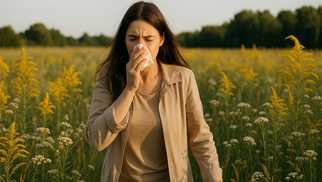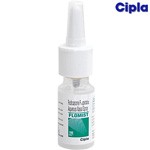Seasonal Allergic Rhinitis: A Comprehensive Guide


Seasonal allergic rhinitis is a common yet often misunderstood condition that affects millions of people worldwide, particularly during spring and autumn. Often referred to as “hay fever,” it is an allergic response to outdoor allergens like pollen, mold spores, and dust particles that are more prevalent during specific seasons. Though it might seem like a mere nuisance to some, untreated allergic rhinitis can significantly affect quality of life, leading to fatigue, poor sleep, and decreased productivity.
In this article, we will explore the nature of seasonal allergic rhinitis, how it differs from general allergic rhinitis, its most common symptoms, triggers to avoid, natural home remedies, and the role of medications such as Flomist spray in its management.
Understanding the Difference Between Allergic Rhinitis and Seasonal Allergies
To clarify the terminology, allergic rhinitis is a broad medical condition characterized by inflammation of the nasal passages due to an allergic reaction. It is caused by allergens — substances that provoke an immune response. These allergens can be either seasonal or perennial (year-round).
Seasonal allergic rhinitis, as the name suggests, flares up during specific times of the year when certain plants pollinate. Spring, with its explosion of tree and flower pollen, and fall, when ragweed is prevalent, are particularly problematic. On the other hand, perennial allergic rhinitis is caused by indoor allergens such as dust mites, pet dander, or mold and can affect individuals throughout the year.
So while seasonal allergies are a subset of allergic rhinitis, the key difference lies in the timing and type of allergen responsible. People with seasonal allergic rhinitis will typically have symptom-free periods during the rest of the year.
Recognizing the Symptoms of Seasonal Allergic Rhinitis
The symptoms of seasonal allergic rhinitis can vary from mild to severe and are often confused with the common cold. However, there are telltale signs that point to an allergic cause rather than an infection. The three hallmark symptoms are:
- Sneezing – Frequent and often occurring in bouts, sneezing is the body’s reflex to expel allergens.
- Nasal congestion and runny nose – This results from inflammation of the nasal lining and increased mucus production.
- Itchy, watery eyes – Allergic reactions commonly affect the eyes, leading to itching, redness, and excessive tearing.
Other associated symptoms may include itching of the throat or ears, postnasal drip, fatigue due to poor sleep, and decreased sense of smell. Unlike colds, these symptoms do not come with fever and do not resolve within a week or so—they persist as long as the allergen exposure continues.
Triggers to Avoid with Allergic Rhinitis
Managing seasonal allergic rhinitis effectively often begins with avoiding exposure to known triggers. While total avoidance is not always possible, minimizing contact with allergens can reduce symptom severity and frequency.
Pollen is one of the most common culprits. Trees release pollen in early spring, grasses follow in late spring and summer, and weeds (like ragweed) release pollen in late summer and fall. Mold spores are also prevalent in fallen leaves and damp environments during these seasons.
Here are some key strategies to limit exposure:
- Stay indoors during high-pollen times, especially early mornings or windy days.
- Keep windows closed at home and in the car to prevent allergens from entering.
- Use air purifiers with HEPA filters and dehumidifiers indoors.
- Shower and change clothes after coming in from outside.
- Avoid yard work like mowing lawns or raking leaves during high-allergen seasons.
Some foods (such as raw apples, melons, or celery) may also cross-react with pollen in sensitive individuals, causing oral allergy syndrome. Identifying and avoiding these foods during peak seasons can be beneficial.
Can Allergic Rhinitis Be Cured Permanently at Home?
The idea of a permanent home cure for allergic rhinitis is appealing, especially for those who prefer natural methods or want to avoid long-term medication use. While a complete and permanent cure is rare without medical intervention such as immunotherapy, significant symptom relief and long-term control can often be achieved through consistent home management and lifestyle changes.
One of the most effective home-based strategies is nasal irrigation using a saline solution. This helps flush out allergens, mucus, and irritants from the nasal passages. A neti pot or saline spray can be used daily, especially after exposure to high-pollen environments.
Boosting the immune system is another approach that may help reduce allergic responses. A balanced diet rich in antioxidants (fruits and vegetables), omega-3 fatty acids (found in fish and flaxseed), and probiotics (found in yogurt or fermented foods) may improve overall immune regulation.
Some people find relief with natural antihistamines such as quercetin, a flavonoid found in onions and apples, or butterbur, an herb with anti-inflammatory effects. However, it is essential to consult a healthcare provider before starting herbal supplements, as they may interact with medications or cause side effects.
Allergen-proofing your home is also key: regular cleaning, dust-mite-proof bedding, and humidity control can significantly lower your allergen load.
While these methods may not offer a complete cure, they can substantially reduce dependence on medication and improve quality of life.
The Role of Flomist Spray in Treating Allergic Rhinitis
Flomist is a nasal spray containing fluticasone propionate, a corticosteroid that helps reduce inflammation in the nasal passages. It is one of the most effective and widely recommended medications for managing allergic rhinitis, particularly moderate to severe cases.
Unlike antihistamines, which block the effects of histamine after an allergic reaction begins, Flomist works at a deeper level by preventing the release of inflammatory substances. This means it needs to be used consistently and proactively, rather than only when symptoms appear.
Flomist reduces nasal swelling, congestion, sneezing, and mucus production. Its full effects may take a few days to become apparent, so regular daily use during allergy season is typically advised.
For optimal results:
- Use Flomist at the same time each day.
- Gently blow your nose before using the spray.
- Tilt your head slightly forward and aim the nozzle slightly outward (not toward the septum) to avoid irritation.
Flomist is generally well-tolerated, though side effects like nasal dryness, minor nosebleeds, or a sore throat may occur. These can usually be managed with proper technique and nasal hydration. Because it is a steroid, long-term use should be monitored by a doctor, especially in children or those with frequent nosebleeds.
Despite not being a “cure,” Flomist offers reliable symptom control and is considered a cornerstone in the pharmacological management of seasonal allergic rhinitis.
Conclusion
Seasonal allergic rhinitis may not be life-threatening, but it certainly disrupts life. Understanding its causes, distinguishing it from other forms of allergic rhinitis, and recognizing its symptoms are essential for early intervention. Simple lifestyle modifications — such as reducing allergen exposure, using saline rinses, and supporting immune health — can go a long way in managing symptoms at home.
For many, however, medications like Flomist nasal spray remain indispensable, offering fast and effective relief during high-pollen seasons. The best approach to seasonal allergic rhinitis is a multifaceted one: combining avoidance strategies, natural remedies, and medical treatments tailored to your needs.
While a permanent home cure remains elusive, a well-informed and proactive management plan can transform allergy season from a dreaded ordeal into a manageable inconvenience.
Medically Reviewed by Dr. Rabeea Aboufakher, MD
(Updated at Jun 12 / 2025)

